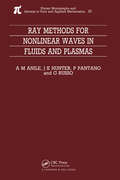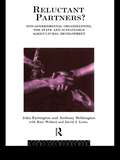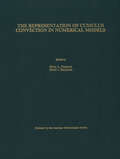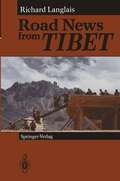- Table View
- List View
Ray Methods for Nonlinear Waves in Fluids and Plasmas (Monographs And Surveys In Pure And Applied Mathematics Ser.)
by Marcelo Anile P Pantano G Russo J HunterPresents in a systematic and unified manner the ray method, in its various forms, for studying nonlinear wave propagation in situations of physical interest, essentially fluid dynamics and plasma physics.
Recent Developments in Quantum Optics
by R. InguvaThis volume is composed of papers (invited and contributed) presented at the International Conference on Coherence and Quantum Optics held at the University of Hyderabad January 5-January 10, 1991. It has been organized by Professor Girish Agarwal and his colleagues at the School of Physics, University of Hyderabad, Hyder abad, India under partial support from the Department of Science and Technology, Government of India, International Center for Theoretical Physics, Trieste, Italy and the National Science Foundation, USA. Without the untiring efforts of Prof. Girish Agarwal and the members of his quantum office group, the Conference and the present volume would not have been possible. Some extraordinary circumstances resulted in a delay of the publication of the present volume. Our sincere apologies to all the authors. We deeply regret the inconvenience caused due to the delay. A debt of gratitude is due to Ms. Kim Bella for the excellent typing job of the different versions and the final version of the manuscript. It is a pleasure to acknowl edge the efforts of Ms. Pat Vann, Mr. Greg Safford and Mr. Eric Katz of the Plenum Publishing, without whose interest and persistence this volume would not have been possible. v CONTENTS QUANTUM OPTICS: THEORY The Quantum Mechanics of Particles in Time-Dependent Quadrupole Fields Roy J. Glauber . . . . . . . . . . . . . . . . . . . . . . . . . . . . . . . . . . . . . . . . . . . . . . . . . . . . . . . . . . . . 1 Localization of Photons in Random and Quasiperiodic Media S. Dutta Gupta . . . . . . . . . . . . . . . . . . . . . . . . . . . . . . . . . . . . . . . . . . . . . . . . . . . . . . . . . . 15 Enhanced Fundamental Linewidth of a Laser Due to Outcoupling W. A. Hamel, M. P. van Exter, and J. P. Woerdman . . . . . . . . . . . . . . . . . . . . . . . .
Recent Developments in Theoretical Fluid Mechanics: Winter School, Paseky, 1992
by G P Galdi J. NecasIncluding previously unpublished, original research material, this comprehensive book analyses topics of fundamental importance in theoretical fluid mechanics. The five papers appearing in this volume are centred around the mathematical theory of the Navier-Stokes equations (incompressible and compressible) and certain selected non-Newtonian modifications.
Recent Developments in Theoretical Fluid Mechanics: Winter School, Paseky, 1992
by G P Galdi J. NecasIncluding previously unpublished, original research material, this comprehensive book analyses topics of fundamental importance in theoretical fluid mechanics. The five papers appearing in this volume are centred around the mathematical theory of the Navier-Stokes equations (incompressible and compressible) and certain selected non-Newtonian modifications.
Recent Evolution and Seismicity of the Mediterranean Region (Nato Science Series C: #402)
by E. Boschi E. Mantovani A. MorelliThe Mediterranean is one of the most studied regions of the world. In spite of this, a considerable spread of opinions exists about the geodynamic evolution and the present tectonic setting of this zone. The difficulty in recognizing the driving mechanisms of deformation is due to a large extent to the complex distribution in space and time of tectonic events, to the high number of parameters involved in this problem and to the scarce possibility of carrying out quantitative estimates of the deformation implied by the various geodynamic hypotheses. However, we think that a great deal of the present ambiguity could be removed if there were more frequent and open discussions among the scientists who are working on this problem. The meeting ofERICE was organized to provide an opportunity in this sense. In making this effort, we were prompted by the conviction that each step towards the understanding of the Mediterranean evolution is of basic importance both for its scientific consequences and for the possibleimplicationsfor society. It is well known, for instance, that the knowledge ofongoing tectonic processes in a given region and of their connection with seismic activity may lead to the recognition of middle long term precursors of strong earthquakes. The few cases of tentative earthquake prediction in the world occurred where information on large scale seismotectonic behavior was available. This led to identify the zones prone to dangerous shocks, where observations of short-term earthquake precursors were then concentrated.
Recent Geodetic and Gravimetric Research in Latin America: Symposium No. 111, Vienna, Austria, August 13, 1991 (International Association of Geodesy Symposia #111)
by James G. Tanner Alvaro GonzálezFletcher WolfgangTorgeThe 18 papers of the book give a comprehensive overview over recent advancesof geodetic research in Latin America. The book is divided in three parts: 1. Geodetic and gravimetric control in Latin America 2. Regional Gravity and Geoid Determination 3. Geodynamic Research Projects The Symposium was held in Vienna, August 1991, at the General Assembly of the International Union of Geodesy and Geophysics.
Rechenübungen zur angewandten Elektronik: Mit 92 Aufgaben und Lösungen, zum Teil mit BASIC-Programmen
by Erwin BöhmerREDUCE: Ein Kompaktkurs über die Anwendung von Computer-Algebra
by Friedrich W Hehl Volker Winkelmann Hartmut MeyerReduced Kinetic Mechanisms for Applications in Combustion Systems (Lecture Notes in Physics Monographs #15)
by Norbert Peters Bernd RoggIn general, combustion is a spatially three-dimensional, highly complex physi co-chemical process oftransient nature. Models are therefore needed that sim to such a degree that it becomes amenable plify a given combustion problem to theoretical or numerical analysis but that are not so restrictive as to distort the underlying physics or chemistry. In particular, in view of worldwide efforts to conserve energy and to control pollutant formation, models of combustion chemistry are needed that are sufficiently accurate to allow confident predic tions of flame structures. Reduced kinetic mechanisms, which are the topic of the present book, represent such combustion-chemistry models. Historically combustion chemistry was first described as a global one-step reaction in which fuel and oxidizer react to form a single product. Even when detailed mechanisms ofelementary reactions became available, empirical one step kinetic approximations were needed in order to make problems amenable to theoretical analysis. This situation began to change inthe early 1970s when computing facilities became more powerful and more widely available, thereby facilitating numerical analysis of relatively simple combustion problems, typi cally steady one-dimensional flames, with moderately detailed mechanisms of elementary reactions. However, even on the fastest and most powerful com puters available today, numerical simulations of, say, laminar, steady, three dimensional reacting flows with reasonably detailed and hence realistic ki netic mechanisms of elementary reactions are not possible.
Regenerative Energiequellen
by Manfred Kleemann Michael MelißSachliche Information verständlich zu vermitteln, ist das Konzept dieses erfolgreichen Lehrbuches. Es behandelt nicht nur physikalische, technische und wirtschaftliche Fragen, sondern zeigt auch die für Deutschland interessantesten Nutzungsmöglichkeiten für regenerative Energiequellen auf. Die 2. Auflage berücksichtigt zusätzlich die neuesten technischen Entwicklungen auf diesem Gebiet.
Reintegrating Fragmented Landscapes: Towards Sustainable Production and Nature Conservation
by Richard J. Hobbs Denis A. SaundersSocial historians will look back on the 1980s as a period when a global consciousness of the environment developed. Stimulated by major issues and events such as oil and chemical spills, clearing of rainforests, pollu tion of waterways, and, towards the end of the decade, concern over the greenhouse effect, concern for the environment has become a major social and political force. Unfortunately, the state of the environment and its future manage ment are still very divisive issues. Often, at a local level, concern for the environment is the antithesis of development. The debate usually focusses on the possible negative environmental impacts of an activity versus the expected positive economic impacts. It is a very difficult task to integrate development and conservation, yet it is towards this objec tive that the sustainable development debate is moving. The issues in the central wheatbelt of Western Australia are typical of the environment versus development debate. It is undoubted that the development of the area, which involved clearing the native vegetation, has had a major impact upon the original ecosystems. Many of the natural habitats are threatened and local extinction of flora and fauna species is a continuing process. Moreover, there are clear signs that land degradation processes such as dryland salinity are depleting the land resource.
Reluctant Partners? Non-Governmental Organizations, the State and Sustainable Agricultural Development (Non-Governmental Organizations series)
by John Farrington Anthony Bebbington Kate Wellard David J. LewisReluctant Partners? combines comprehensive empirical insights into NGOs' work in agriculture with wider considerations of their relations with the State and their contribution to democratic pluralism. This overview volume for the Non-Governmental Organizations series contextualizes and synthesizes the case study material in the three regional volumes on Africa, Asia and Latin America, where over sixty specially commissioned case studies of farmer-participatory approaches to agricultural innovation are presented.Specific questions are raised. How good/bad are NGOs at promoting technological innovation and addressing contraints to change in peasant culture? How effective are NGOs at strengthening local organizations? How do/will donor pressures influence NGOs and their links to the State?
Reluctant Partners? Non-Governmental Organizations, the State and Sustainable Agricultural Development (Non-Governmental Organizations series)
by Anthony Bebbington John Farrington David J. Lewis Kate WellardReluctant Partners? combines comprehensive empirical insights into NGOs' work in agriculture with wider considerations of their relations with the State and their contribution to democratic pluralism. This overview volume for the Non-Governmental Organizations series contextualizes and synthesizes the case study material in the three regional volumes on Africa, Asia and Latin America, where over sixty specially commissioned case studies of farmer-participatory approaches to agricultural innovation are presented.Specific questions are raised. How good/bad are NGOs at promoting technological innovation and addressing contraints to change in peasant culture? How effective are NGOs at strengthening local organizations? How do/will donor pressures influence NGOs and their links to the State?
Remote Sensing Digital Image Analysis: An Introduction
by John A. RichardsPossibly the greatest change confronting the practitioner and student of remote sensing in the period since the first edition of this text appeared in 1986 has been the enormous improvement in accessibility to image processing technology. Falling hardware and software costs, combined with an increase in functionality through the development of extremely versatile user interfaces, has meant that even the user unskilled in computing now has immediate and ready access to powerful and flexible means for digital image analysis and enhancement. An understanding, at algorithmic level, of the various methods for image processing has become therefore even more important in the past few years to ensure the full capability of digital image processing is utilised. This period has also been a busy one in relation to digital data supply. Several nations have become satellite data gatherers and providers, using both optical and microwave technology. Practitioners and researchers are now faced, therefore, with the need to be able to process imagery from several sensors, together with other forms of spatial data. This has been driven, to an extent, by developments in Geographic Information Systems (GIS) which, in tum, have led to the appearance of newer image processing procedures as adjuncts to more traditional approaches.
Renormalization: From Lorentz to Landau (and Beyond)
by Laurie M. BrownThe purpose of this section is to give you a sketch of how quantum field theory works, where Feynman graphs come from and why they are so useful, where the infinities come from, and how we have learned to deal with them without compromising the physical principles involved. I am purposely treating the problem at the level of the 1940s and 1950s, so as to keep the basic ideas clear and avoid the more difficult problems and more sophisticated methods of recent years. I shall relate my discussion simply to quantum electrodynamics (QED) since that is the most familiar case and the case that was in the forefront from the beginning (though in fact I shall ignore many of the special complications that have to be dealt with when you quantize a gauge field). The methods I shall be describing are applicable to all sorts of quantized fields: the detailed factors are different but the structure of the logical development isjust the same. Not surprisingly, though, the renormalization procedure breaks down if the theory in question is nonrenormalizable. Whether nonrenormalizable theories are theories at all is a matter for debate; in any case, they hold no practical interest for physicists since they are essentially unusable. Quantum electrodynamics was devised in 1927 by Dirac, less than a year after the Schrodinger equation appeared and before the Dirac equa tion for the relativistic electron had been invented.
The Representation of Cumulus Convection in Numerical Models (Meteorological Monographs)
This book presents descriptions of numerical models for testing cumulus in cloud fields. It is divided into six parts. Part I provides an overview of the problem, including descriptions of cumulus clouds and the effects of ensembles of cumulus clouds on mass, momentum, and vorticity distributions. A review of closure assumptions is also provided. A review of "classical" convection schemes in widespread use is provided in Part II. The special problems associated with the representation of convection in mesoscale models are discussed in Part III, along with descriptions of some of the commonly used mesoscale schemes. Part IV covers some of the problems associated with the representation of convection in climate models, while the parameterization of slantwise convection is the subject of Part V.
Representation of Lie Groups and Special Functions: Volume 2: Class I Representations, Special Functions, and Integral Transforms (Mathematics and its Applications #74)
by N.Ja. Vilenkin A.U. KlimykRoad News from Tibet
by Richard LanglaisA satellite passes. It dips lower in its orbit to have a closer look at Central Asia. The sweep of its vision glosses the Celestial Mountains and the Mountains of Chaos. Its prying lenses probe the Taklamakhan, the Himalaya and the headwaters of Asia's greatest rivers. Mother Ganges, the Brahmaputra and the Yellow River, the Salween, Yangtze and Mekong all lie exposed beneath its arc. It's focus is Tibet. At least a few satellites pass over Tibet these days. Their observations are crisp and hard, terse and digital. Statistics are collected while hardy people sleep softly on the land below. Most of the Tibetan people have never heard of satellites. They revere the sun, the moon and the stars, while respecting the harsh winds that can change the temper of a day in moments. Although some of the stars are seen to move very quickly now, the Tibetans' spiritual centre remains Lhasa, around which their lives gravitate no matter how far away from it their homes might be.
The Role of the Stratosphere in Global Change (Nato ASI Subseries I: #8)
by Marie-Lise ChaninScientists concerned with the processes occurring in the stratosphere are becoming more and more aware of the role that the stratosphere may play in the global climate and in global change in general. This book focuses on the basic processes taking place in the stratosphere and on the stratospheric changes which may occur from either natural or anthropogenic forcing. Of major concern here is the consequence of the increasing Antarctic Ozone Hole and the possibility of similar processes occurring at northern latitudes. One of the expected consequences of the change in the stratospheric composition, mainly ozone depletion, is the change in the penetration of UV-B in the troposphere, at the surface, and in the top layers of the ocean. Monitoring and modeling of those changes are still in infancy, even though the implications may be of utmost importance for the entire biosphere. Several aspects of these consequences with regard to aquatic ecosystems, terrestrial vegetation and human health are presented by experts in these fields.
Rossby Vortices, Spiral Structures, Solitons: Astrophysics and Plasma Physics in Shallow Water Experiments (Springer Series in Nonlinear Dynamics)
by Mikhail V. Nezlin Evgenii N. SnezhkinThis book can be looked upon in more ways than one. On the one hand, it describes strikingly interesting and lucid hydrodynamic experiments done in the style of the "good old days" when the physicist needed little more than a piece of string and some sealing wax. On the other hand, it demonstrates how a profound physical analogy can help to get a synoptic view on a broad range of nonlinear phenomena involving self-organization of vortical structures in planetary atmo spheres and oceans, in galaxies and in plasmas. In particular, this approach has elucidated the nature and the mechanism of such grand phenomena as the Great of galaxies. A number of our Red Spot vortex on Jupiter and the spiral arms predictions concerning the dynamics of spiral galaxies are now being confirmed by astronomical observations stimulated by our experiments. This book is based on the material most of which was accumulated during 1981-88 in close cooperation with our colleagues, experimenters from the Plasma Physics Department of the Kurchatov Atomic Energy Institute (S. V. Antipov, A. S. Trubnikov, AYu. Rylov, AV. Khutoretsky) and astrophysics theoreticians from the Astronomical Council of the USSR Academy of Sciences (AM. Frid man) and from the Volgograd State University (AG. Morozov). To all of them we wish to express our gratitude. Whenever we speak of "our experiments", the participation of the entire team is implied.
Round River (Galaxy Books)
by Aldo LeopoldTo those who know the charm of Aldo Leopold's writing in A Sand County Almanac, this collection from his journals and essays will be a new delight. The journal entries included here were written in camp during his many field trips--hunting, fishing, and exploring--and they indicate the source of ideas on land ethics found in his longer essays. They reflect as well two long canoe trips in Canada and a sojourn in Mexico, where Leopold hunted deer with bow and arrow. The essays presented here are culled from the more contemplative notes which were still in manuscript form at the time of Leopold's death in 1948, fighting a brush fire on a neighbor's farm. Round River has been edited by Leopold's son, Luna, a geologist well-known in the field of conservation. It is also charmingly illustrated with line drawings by Charles W. Schwartz. All admirers of Leopold's work--indeed, all lovers of nature--will find this book richly rewarding.
Routledge Revivals (1993): The Offshore Oil Industry's Development of the Outer Contintental Shelf
by Geoffrey C. LaendnerFirst published in 1993, this book traces and analyses the changing policies of American offshore oil companies concerning the exploration and development of the Outer Continental Shelf in the period from 1970 to 1976 — covering environmental legislation, the oil embargo, presidential initiatives, and proposed international laws. Where previous studies concerning the Outer Continental Shelf had only examined broad policy issues on an international level, this study focuses on those American offshore companies who were major actors in ocean affairs, especially in the exploration and development of the region.
Routledge Revivals (1993): The Offshore Oil Industry's Development of the Outer Contintental Shelf
by Geoffrey C. LaendnerFirst published in 1993, this book traces and analyses the changing policies of American offshore oil companies concerning the exploration and development of the Outer Continental Shelf in the period from 1970 to 1976 — covering environmental legislation, the oil embargo, presidential initiatives, and proposed international laws. Where previous studies concerning the Outer Continental Shelf had only examined broad policy issues on an international level, this study focuses on those American offshore companies who were major actors in ocean affairs, especially in the exploration and development of the region.
Saturated Flow and Soil Structure: A Review of the Subject and Laboratory Experiments on the Basic Relationships (Springer Series in Physical Environment #14)
by Heiko DiestelSoil and water pollution have a serious impact on the environment, and soil scientists and hydrologists need fundamental help for the estimation of the consequences. The experiments described in this volume deal with the quantification of the morphology of interaggregate voids and of the flow through such voids as well as around impermeable inclusions. The diagrams given in the appendix can be used as references for such measurements. This work is put into the context of the international literature on the subject. An index and a glossary complete the volume. The subject of this work is of great interest to hydrologists and soil scientists working on the estimation of the consequences of soil and water pollution.





















